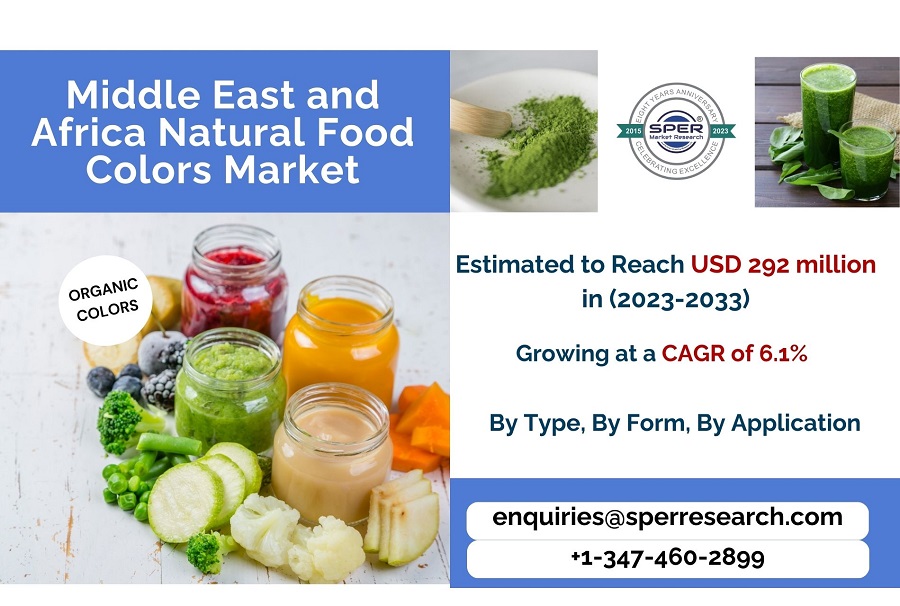MEA Natural Food Colors Market Growth, Trends, Share, Size, Revenue, Key Players, Challenges and Future Opportunities Till 2033: SPER Market Research

Food colouring agents that come from plants, animals, or minerals are known as natural food colouring agents. They can also be dyes or pigments. One of the most well-known sources of natural food colouring is beetroot, followed by grass, and turmeric. When used as a food additive, natural food colours or dyes are harmless because they don’t have any negative side effects and are primarily derived from fruits, vegetables, animals, insects, and minerals. The use of natural colours for medicinal purposes is growing as well because they are less harmful and have less adverse effects.
According to SPER market research, ‘Middle East and Africa Natural Food Colors Market– By Type, By Form, By Application- Regional Outlook, Competitive Strategies and Segment Forecast to 2033’state that the Middle East and Africa Natural Food Colors Market is predicted to reach USD 292 million by 2033 with a CAGR of 6.1%.
The Middle East and Africa’s heavy reliance on importing natural food colours is a result of their limited industrialization, erratic power supplies, and ineffective transit systems. The market is anticipated to grow further due to the increasing urbanisation and consumer desire for beverages and processed meat with natural additives. The market for natural food colours is projected to rise in response to rising disposable incomes, particularly in Middle Eastern travel areas. The demand for natural colouring is expected to rise due to the region’s commitment to the growing natural food trend and new labelling requirements from the Gulf Cooperation Council (GCC). Manufacturers are focusing on clean label products as a result of the growing demand for processed and convenient foods made with natural ingredients from health-conscious immigrant groups.
Conversely, the market expansion of MEA natural food colours is impeded by the increased expense of natural components. The market is growing because of the adverse effects of food colouring and the strict laws that have been put in place regarding the use of artificial colouring. Furthermore, the growth of the worldwide industry is hampered by the high price of natural colours. It is anticipated that market growth will be slowed by the high cost of encapsulated components, which prevents broad commercialization. During the projection period, the food colour encapsulation market will face challenges due to limited market commercialization caused by strict restrictions.
Request For Free Sample Report @https://www.sperresearch.com/report-store/middle-east-natural-food-colors-market.aspx?sample=1
Impact of COVID-19 on MEA Natural Food Colors Market
Consumers’ demand to know the source of their food has increased because to the COVID-19 epidemic, yet food cost is still a key worry for consumers globally. Customers’ worry of contracting an infection from consuming more imported goods with an unclear and unidentified ingredient origin has also led to a rise in the demand for food made locally. It has helped local producers of natural colouring agents as well as new private label players in the food business. Global demands to restrict and ultimately stop the development of the COVID-19 pandemic are generated by the scientific and medical institutions’ recommendation that people use nutraceuticals to boost immunity and health. This is advantageous for the natural food colouring business.
Geographically, the market is divided into South Africa, Saudi Arabia, the United Arab Emirates, and the rest of MEA based on country. The market share in 2022 was led by the rest of MEA.
Middle East and Africa Natural Food Colors Market Key Players:
Additionally, some of the market key players are Archer Daniels Midland Company, BASF SE, Döhler Group, DuPont, Givaudan S.A., Koninklijke DSM N.V., Naturex S.A., Oterra A/S, and Sensient Technologies Corporation, Others, Others.
Middle East and Africa Natural Food Colors Market Segmentation:
By Type: Based on the Type, Middle East and Africa Natural Food Colors Market is segmented as; Annatto, Anthocyanins, Caramel, Carmine, Carotenoids, Chlorophyll, Curcumin, Others.
By Form: Based on the Form, Middle East and Africa Natural Food Colors Market is segmented as; Gel, Liquid, Powder.
By Application: Based on the Application, Middle East and Africa Natural Food Colors Market is segmented as; Bakery and Confectionery, Beverages and Sauces, Dairy and Frozen Desserts, Dressings and Condiments, Meat, Poultry and Seafood, RTC and RTE Products, Others.
By Region: This research also includes data for Saudi Arabia, South Africa, UAE and rest of MEA.
This study also encompasses various drivers and restraining factors of this market for the forecast period. Various growth opportunities are also discussed in the report.
For More Information, refer to below link:-
Middle East and Africa Natural Food Colors Market Revenue
Related Reports:
Follow Us –
LinkedIn | Instagram | Facebook | Twitter
Contact Us:
Sara Lopes, Business Consultant – U.S.A.
SPER Market Research
+1-347-460-2899





